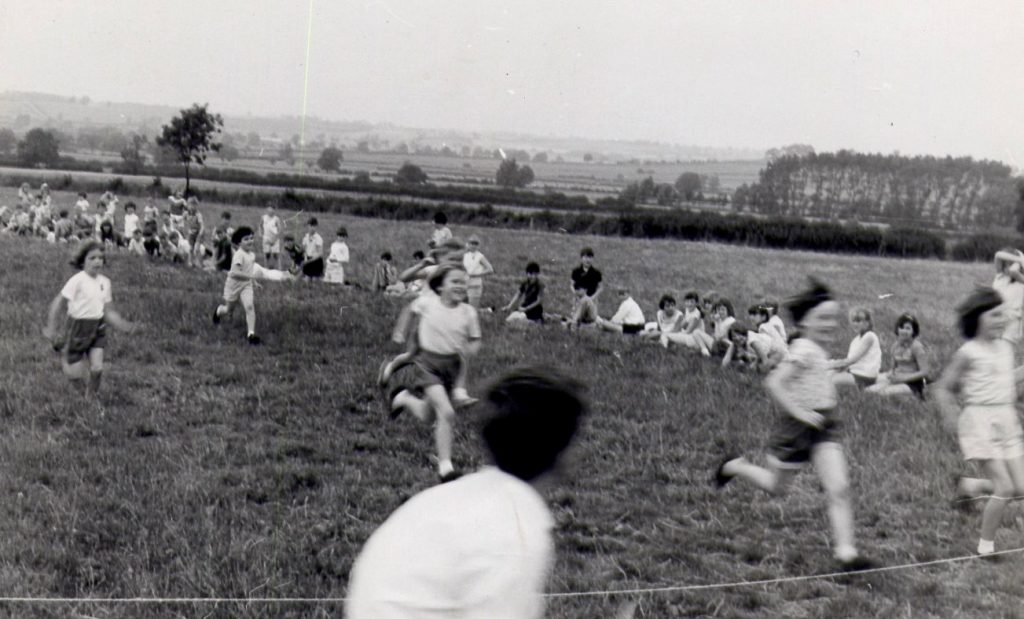Education timeline
17th/18th Century, Dame Schools
In the 17th Century, education was mainly the prerogative of the rich. However, there was some kind of education available for the less privileged in the form of dame schools also known as ‘common day schools’. These were run from a kitchen, or outbuilding, by an untrained woman with enough ability to teach basic reading, handwriting and arithmetic, as well as practical skills like sewing. It is believed that there used to be a dame school in Cottingham on the right hand side of the pathway that leads up to the Royal George from Corby Road. This is now a private garden, and former owners Laurie and Irene Beadsworth recall finding a set of steps beneath the garden when they were excavating for a new driveway. In her will, Mrs Catherine Palmer left £100 to the poor of Cottingham and Middleton, with the 4% interest thereon "to a school-dame of character to teach 10 girls of the said parish".
1766, Middleton School
In February 1766, the village copyholders built a school and a dwelling house for a master on land owner by Sir John Palmer on what is now Camsdale Walk (No.7). The schoolmaster received £7 a year to instruct 10 boys as free scholars in the three Rs, making up his salary by taking in fee paying students. In 1856 and again in 1869, the Church of England National School Society expanded the school in Middleton to eventually cater for 120 children.
The White House, Dag Lane, 1800s
Prior to 1871, it's believed there was a schoolroom at The White House on Dag Lane (later School Lane). The 1861 census lists many children on Dag Lane as scholars, and villagers remember the lounge of the White House having high windows and a vaulted ceiling. This is also the room where, in the late 1800s, artist Alice Pery did her painting.
1871, Cottingham School
Following the passing of the 1870 Education Act, the school on Dag Lane, Cottingham was built, initally for infants (aged 3-7 years) from both villages, with the junior age children of both villages being educated in Middleton. On the opening day of 5 June 1871, 92 children were admitted, and the school journal (see below) mentions assistance from Mrs Vickers, who was "formerly mistress of a dame's school in the village".
1900s curriculum
At the turn of the 20th century, the school curriculum would have been arithmetic, poetry, reading, composition, recitation, geography (British colonies), history (to 1066), nature study, drawing, drill, music and needlework.
1960s/70s, Berryfield Road
The current Cottingham CofE Primary School on Berryfield Road was opened in the late 1960s. The old Cottingham school was kept open alongside the new one for a few years, but eventually closed in the early 1970s and is now a private house, as are the old Middleton school and master's house on Camsdale Walk.
Cottingham & Middleton Infant School Journal, 1871-1901
Sue Hall has kindly given us a typewritten transcript of the journal from Cottingham and Middleton Infant School on Dag Lane (School Lane), from the day it opened on 5 June 1871 through to April 1901. It has very generously been scanned into electronic format by Mik Chapman from Contract Printing in Corby.
The journal provides a fascinating insight into the day-to-day life of the school, including that children often seemed to stay off school in wet weather and were absent to help glean and take dinner to the fields during harvest time.
On 7 Decemer 1899, resulting from a severe outbreak of fever in the village and amongst the schoolchildren, Dr Dryland, Rural Sanitary Medical Officer (Kettering) ordered that the school be closed for four weeks until after the Christmas break. The school was closed again for a month in Jan/Feb 1891 due to an outbreak of fever.
The Hon. Alice Pery occasionally visited the school to teach scripture, and there were regular visits from Rev. W. Yates. His relationship with school was such that the school closed on the afternoon of 16 July 1900 due to his sudden passing, and again on 19 July for his funeral, with the journal citing: “a terrible blow to the Teachers and all Parishioners to lose our beloved Rector”.
The journal mentions school mistresses Rachel Oke, Elizabeth Goodacre/Pallett, Annie Beecroft (1894-1896;1898-) and Sarah A. Coley (Feb 1896-Sep 1898); teachers J Bamford, Sarah Bradshaw, Elizabeth Chambers, Elizabeth Sturman (replacing Ada Mayson), Susan J. Sturman, Miss Nance, MA Webster and Alice Vickers; Monitors Mary Ann Aldwinckle, Florence Ingram, Geraldine Jackson, Eleanor Simpson, Alice and Mildred Bottrill (replaced by Elizabeth Vickers and then Mary Maydwell), Bessie Shrive.
In the journal, there are also lots of surnames of pupils that you may recognise including Aldwinckle, Almond, Ansley, Ashley, Bailey, Baker, Bamford, Beesworth, Best, Betts, Binley, Bland, Boothe, Bottrill, Bradshaw, Brown, Bush, Buswell, Button, Cannam, Carter, Chappell, Claypole, Clow, Coaten, Coleman, Coles, Costen, Crane, Crafford, Craxford, Cross, Damms, Darker, Darnell, Dean, Dexter, Dolby, Dunckley/Dunkley, Eaton, Edwards, Elner, Foster, Gilbert, Goode, Graves, Green, Groocock, Hatfield, Hearsley, Hobbs, Holdick/Holdich, Hobbs, Horsley, Hurman, Kemshead, Jackson, Jarvis, Johnson, Knight, Langley, Layton, Lickerish, Lewin, Maydock, Mayson, Mickey, Oliver/Olliver, Palmer, Pauler, Robinson, Scarr, Silby, Simpson, Spriggs, Stanyer, Stanyon, Stokes, Swingler, Tansley, Tilley, Timson, Vickers, Vye, Wallace, Ward, Webster, West, White, Wilks, Wolfe/Woolfe.
Early 1900s, Thomas ‘Tubby’ Beecroft
Thomas Beecroft was headmaster from 1894 to 1923. His wife Annie Beecroft was mistress of the Infants School from 2 April 1894 until her retirement from ill health in 1896, returning as schoolmistress in September 1898, following the resignation of Sarah A. Coley (Feb 1896-Sep 1898).
You can view Mr Beecroft’s resignation letter and retirement presentation here Source: Pam Moore. He was succeeded by Henry Belshaw, who was headmaster at the school from 1924-1926.












Late 1920s to early 1950s, Mr LV Porter
Mr LV Porter took over as headmaster from Henry Belshaw in the late 1920s. He was also the local Scout master. He died of a heart attack in 1952.




Pat Licquorish recalls that she and other children from the school were taken to London to see the forthcoming preparations for the Coronation of Queen Elizabeth II in 1952 or 1953. It was a Friday, as she recalls being woken the next day (Saturday) to be told by her mother that Mr Porter had died in the night. It was quite a shock, as he had accompanied them on the trip to London.
Late 1920s to early 1970s, Allston A Kisby
Mr Allston A Kisby was a class teacher at the school in the 1920s and subsequently became headmaster.



Mr Kisby was a firm favourite with the children. Irene Beadsworth (nee Ansell) recalls him with fondness. “He was everybody’s favourite teacher” says Irene. “He was the most wonderful storyteller and he loved art and poetry. He even wrote a book!”
Judi Davies-Stephenson, who attended the school in the 60s and 70s, also remembers Mr Kisby. She says: “before he died, he gave away to the students at the school a lot of his sketches and drawings. He was really an amazing artist! I was lucky enough to get one of a willow tree…I also remember very well Mrs David the school cook. she looked after me very well…”
David Dodd recalls: “Mr Kisby once a beautiful etching of a fish about to be caught by a fisherman’s hook. Sadly, somewhere over the years it has been lost. The other thing I remember about him was his frequent reference to his daughter Rosemary. She was about the same age as our class, but did not attend Cottingham school. I don’t think we ever met her, but she was the yardstick against which he measured our academic progress.”
Glyn Ball took over from Mr Kisby as headmaster (in the 1970s?).
The following pictures were taken by local photographer Bob Loake on the last day of term before the Easter break in 1976. The teachers are Mrs Toy (joined the school around 1951 and lived in East Carlton Park) and Sue Beadsworth. Thanks to Lynette Muir (nee Licquorish) and Mike Beadsworth for these photos. Other teachers that ex-pupils remember are Mrs Licquorish, Miss Williams, Miss Leahy, Mrs Brown and Mrs Muggleton.
Sally Bee (nee Beadsworth) said: “I remember Mrs Toy as a kind, white haired lady, she used to read us stories like the Lion the Witch and the Wardrobe sitting on a high backed stool.” There are a few names on some of these pictures. Click on any of the pics to view.




Memories of the Old School
Former pupils remember having to walk across the courtyard to the cold, damp outside toilets and the loo roll being ‘like tracing paper’. “The milk was always warm in the summer”, says Mandy McDade, “and those outside toilets were a no no! I waited until I got home!”
Nic Collins says: “I can remember strategically placing wax crayons on the central heating pipes just before going home time and taking great joy in the melted mess on the floor the next morning!
Linda Franklin says: “I remember playing marbles by the old boiler (it was massive, or maybe I was just small) either way fond memories. I loved the old school kitchen, the memories give Downton Abbey vibes.” And Kim Moore recalls eating baked potatoes that been wrapped in foil and cooked inside the boiler, with the children having carved their initials into them before being cooked.
Lots of people remember school cook May David, who used to live at the far end of Church Street in the cottage that is now called ‘May’s cottage’, in her memory.




